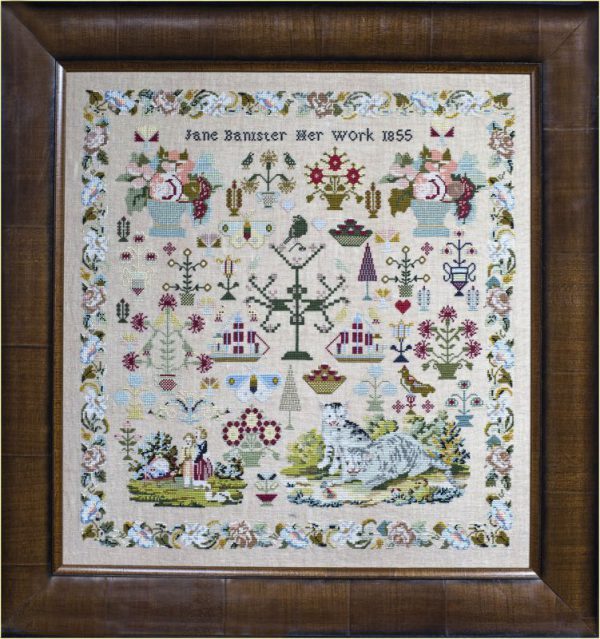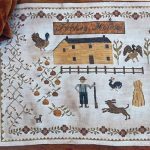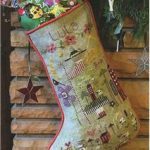Description
Jane Bannister 1855
A Welsh Sampler from the Isle of Anglesey
Hands Across the Sea Samplers
LINEN SIZES
The design area is 309 stitches (w) x 319 stitches (h).
Calculations have included a 3” margin for finishing and framing.
28ct ~ Design: 22.07″ x 22.79″ Fabric: 28.07″ x 28.79″
30ct ~ Design: 20.60″ x 21.27″ Fabric: 26.60″ x 27.27″
32ct ~ Design: 19.31″ x 19.94″ Fabric: 25.31″ x 25.94″
36ct ~ Design: 17.17″ x 17.72″ Fabric: 23.17″ x 23.72″
40ct ~ Design: 15.45″ x 15.95″ Fabric: 21.45″ x 21.95″
46ct ~ Design: 13.43″ x 13.87″ Fabric: 19.43″ x 19.87″
Soie d’Alger / DMC
F02 x 2 / 712 x 2 ~ Cream
111 x 1 / 775 x 1 ~ Baby blue ~ very light
163 x 1 / 823 x 1 ~ Navy blue ~ dark
525 x 2 / 831 x 2 ~ Golden olive ~ medium
943 x 1 / 321 x 1 ~ Christmas red
1026 x 2 / 498 x 2 ~ Christmas red ~ dark
1744 x 1 / 518 x 1 ~ Wedgewood ~ light
1812 x 2 / 504 x 2 ~ Blue green ~ very light
2223 x 1 / 733 x 1 ~ Olive green ~ medium
2242 x 1 / 3046 x 1 ~ Yellow beige ~ medium
2522 x 2 / 677 x 2 ~ Old gold ~ very light
2535 x 1 / 728 x 1 ~ Golden yellow
S2578 x 1 / 3773 x 1 ~ Desert sand ~ medium
2641 x 1 / 353 x 1 ~ Peach
2642 x 1 / 352 x 1 ~ Coral ~ light
3421 x 1 / 3072 x 1 ~ Beaver grey ~ very light
3713 x 1 / 3013 x 1 ~ Khaki green ~ light
3714 x 1 / 3364 x 1 ~ Pine green
3721 x 1 / 524 x 1 ~ Fern green ~ very light
3725 x 1 / 935 x 1 ~ Avocado green ~ dark
3734 x 2 / 3012 x 2 ~ Khaki green ~ medium
3812 x 1 / 422 x 1 ~ Hazel nut brown ~ light
3841 x 1 / 648 x 1 ~ Beaver grey ~ light
3844 x 1 / 646 x 1 ~ Beaver grey ~ dark
4141 x 1 / 3772 x 1 ~ Desert sand ~ very dark
4245 x 1 / 420 x 1 ~ Hazel nut brown ~ dark
4523 x 1 / 3064 x 1 ~ Desert sand
4921 x 1 / 3755 x 1 ~ Baby blue
5022 x 1 / 503 x 1 ~ Blue green ~ medium
5023 x 1 / 502 x 1 ~ Blue green
Blanc x 1 / White x 1 ~ White
Noir x 1 / 310 x 1 ~ Black
From the Hands Across the Sea Samplers Page: “Jane’s beautiful Welsh sampler is a delight for the eye, the more you look at her the more you will see! With a wonderful palette of 32 colours Jane filled her sampler with traditional Welsh motifs contained within a stunning floral border. Roses, lilies and convolvulus in full bloom graciously sweep around this beautiful sampler. Jane diligently stitched pretty vases of flowers such as Ragged Robins from the Lychnis family, and Auriculas in the Primula family, two sailings ships, birds and butterflies abound, and two beautiful bowls of fruit.
The moment we saw Jane’s cats we knew that Hands Across the Sea Samplers had to reproduce this sampler for ailurophiles to stitch. Cats appear in two scenes. To the bottom left a cat quietly watches two “merchs fach” (young girls) contemplate their day but it is at the bottom right where they really make their presence known. Two very large silver tabbies are seen frolicking with a ball in the garden. For us they are the highlight of this wonderful sampler.
We know of one other sampler that is reminiscent of Jane’s. The sampler was stitched by Mary Martin and was finished one year after Jane’s in 1856. We have found a Jane Bannister and a Mary Martin in the 1848 births records of the registration district of Bangor, Caernarvonshire, Wales. Bangor lies on the coast of North Wales near the Menai Strait which separates the island of Anglesey from the mainland. We have found Jane in the 1841 census return and Mary in the 1851 census return. Both censuses note that the girls were born on the Island of Anglesey. On August 15th, 1870 in Brymbo, Denbighshire Jane married Samuel Roberts. The 1881 census records that they had four children and were living in the village of Llay, not far from Wrexham.
Jane’s sampler is what Welsh sampler lovers affectionately call a “Welsh Woolly”. Numerous 19thcentury Welsh samplers were stitched with wool on Penelope Canvas, a double thread canvas ground. During the Victorian period Berlin woolwork a type of embroidery worked in worsted wools imported from Germany, was hugely popular. Printed patterns books became readily available and it is probable that Jane’s needlework teacher used the patterns from such books in her classroom.
Whilst there are 18th century Welsh samplers in museums and private collections the majority of surviving documented Welsh samplers were stitched in the later half of the 19th century. As the century progressed Victorians realised that people from all levels of society needed to be able to read and write, and education became more important. The Church of England became active in education and erected “National Schools” which taught children reading, writing, arithmetic and religion. Sewing and stitchery became an integral part of a schoolgirl’s education and much classroom time was spent practising stitches.”




